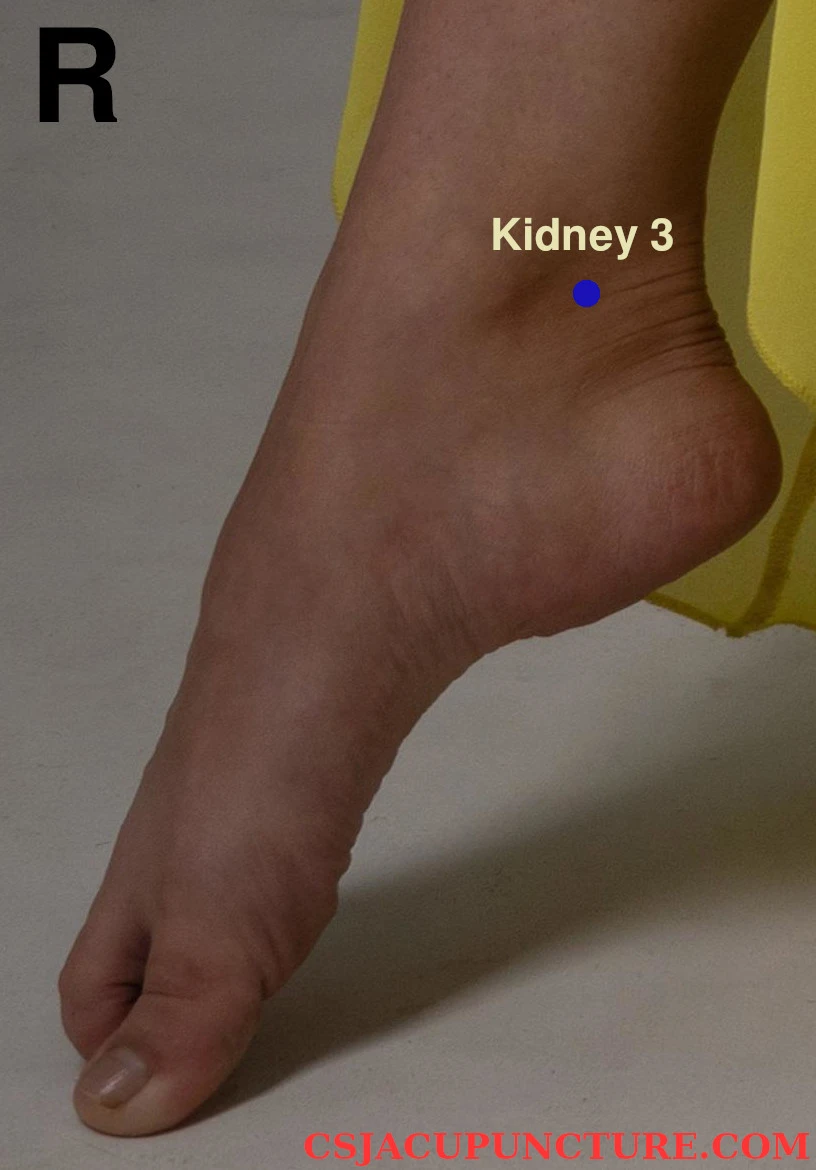This post may contain affiliate links and ads in which we may earn a small percentage of purchases.
Kidney 3 (Kd 3, Taixi or “Greater Stream” ) is an important point to discuss due to its wide range of benefits and frequent use in acupuncture. As a yuan-primary point (the major, or primary point on a meridian), it holds significant energy for the kidney meridian, serving as a powerful tool in treatments related to overall vitality.
Ease back and neck tension with this full acupressure mat and pillow set designed for relaxation and circulation support.
 View Product
View Product
Quick Links
Kidneys Are Vital For Survival
From a biomedical perspective, the kidneys are vital, regulating critical functions such as blood filtration and hormonal balance. In cases of kidney disease—whether acute or chronic—treatment is essential, and in chronic conditions, kidney failure often requires transplantation. This emphasizes the fundamental importance of the kidneys in maintaining life and vitality in both TCM and modern medicine.
In Traditional Chinese Medicine (TCM), the kidneys are also considered the source of essential vitality, playing a crucial role in one’s overall health. The kidneys in TCM are responsible for the body’s core power, influencing not only genetics but also the vital essence, or “Jing,” which fuels growth, development, and reproduction. Jing is seen as the pure vital substance that is linked to hormonal production in the brain, spine, and adrenal glands.
Portable dual-channel TENS/EMS device with 24 therapy modes for targeted muscle and pain relief.
 View Device
View Device
A clear and beginner-friendly guide covering over 400 acupuncture points, ideal for students and learners.
 View Book
View Book
A stainless-steel acupuncture pen and gua sha set for massage, reflexology, and tension relief.
 View Product
View Product
In biomedicine, the urinary and nervous systems are considered distinct systems. However, in acupuncture theory, we derive the primary physiological and pathological functions of a point by studying patterns and identifying similarities across different systems. This integrative approach allows us to better understand the functions of specific acupuncture points through a bio-medical perspective.

Ready to uncover who your true soulmate is? Discover the face, energy, and connection meant for you with a personalized Soulmate Reading. Reveal your soulmate today →
Kidney 3 Point Location
The location of Kidney 3 is found between the Achilles tendon and the medial malleolus of the tibia. To locate the point, measure the distance between these two landmarks and find the midpoint—this is where Kidney 3 is situated. As indicated in book Chinese Acupuncture and Moxibustion (CAM):
The depression in-between the tip of the medial malleolus and Achilles’ tendon.

For Kidney 3 (KD-3), the arteries that pass closely by include:
- The posterior tibial artery runs along the medial side of the ankle, near the Achilles tendon.
- The medial malleolar artery, a branch of the posterior tibial artery as it supplies the area around the medial malleolus.
These arteries are important to be mindful of when needling this point, especially since KD-3 is in close proximity to the posterior tibial artery. Palpating before needling is essential and is done every time.
Needle depth for Kidney 3 is .25 – .5 cun.
Functions of Kidney 3
Kidney meridian belongs to Foot Shaoyin.
TCM Functions according to Giovanni1
- Tonify Kidneys (Yin / Yang)
- Calms the mind
- Benefits Essence (here is a brief explanation)
- Strengthens the low back and knees
- Regulates the uterus
Indications (Giovanni)
- Backache
- Dizziness
- Tinnitus
- Exhaustion
- Feeling cold
- Cold and weak knees
Indications (CAM)2:
- Sore throat
- Toothache
- Tinnitus
- Dizziness
- Spitting of blood
- Asthma
- Irregular menstruation
- Nocturnal emission
- impotence
- frequent micturition (urination)
Kidney 3 and Ankle Swelling (Edema)
Depending on the patient’s condition, Kidney 3 is also an area prone to ankle swelling, making it a common point for fluid retention. When locating the point, adjustments may be necessary, especially in older patients, as they often accumulate more edema in the feet. For more information on edema and its causes, I’ve written an article covering this topic in detail.
Acupressure and Moxibustion at Kidney 3
Acupressure can be applied to Kidney 3 to activate the point and reduce swelling in the area. Moxibustion can be used at this point as well.
Limitations of Kidney 3
Acupuncture is not designed to stop acute or chronic kidney failure. As per law (here in California) patients must be under appropriate care.
Kidney 3 Research
A 2014 study published in the Neural Regeneration Research journal looked at 12 elderly adults with mild cognitive impairment and 12 elderly adults without cognitive impairment. The results suggest that acupuncture at kidney 3 in elderly patients with mild cognitive impairment can also activate some brain regions.3 The chart below shows the 20 brain regions that were activated in both groups.
A 2011 study in rats examined the effects of Kidney 3 and kidney proteins. There were nine protein spots with three-fold up-regulation in the kidney after the acupuncture.4
A 2019 cadaver dissection research study aimed at finding distinct neuroanatomical structures associated with the kidney meridian acupuncture points including Kidney 3 reveal underneath a trifurcation of the posterior tibial nerve and connections to muscles in the foot.5
Interested in integrative health? Sign up for our newsletter below and get the best in news and informative perspective.
References
- Maciocia G. The Foundations of Chinese Medicine: A Comprehensive Text for Acupuncturists and Herbalists. 2nd ed. Edinburgh: Churchill Livingstone; 2005. p. 1007-1008. ↩︎
- Cheng X. 1999. Chinese Acupuncture and Moxibustion. Beijing: Foreign Languages Press; 2010. p. 192. ↩︎
- Chen S, Xu M, Li H, et al. Acupuncture at the Taixi (KI3) acupoint activates cerebral neurons in elderly patients with mild cognitive impairment. Neural Regen Res. 2014;9(11):1163-1168. doi:10.4103/1673-5374.135319 ↩︎
- Li CR, Cheng ZD, Zhang ZX, Kim A, Ha JM, Song YY, Zheng J, Chen YG. Effects of acupuncture at Taixi acupoint (KI3) on kidney proteome. Am J Chin Med. 2011;39(4):687-92. doi: 10.1142/S0192415X11009123. PMID: 21721149. ↩︎
- Lee M, Longenecker R, Lo S, Chiang P. Distinct neuroanatomical structures of acupoints Kidney 1 to Kidney 8: A cadaveric study. Med Acupunct. 2019;31(1):19-28. doi:10.1089/acu.2018.1325. ↩︎
Medical Disclaimer: This article is for informational and educational purposes only and is not a substitute for professional medical advice, diagnosis, or treatment. Always consult a qualified healthcare provider with any questions about a medical condition or treatment.






